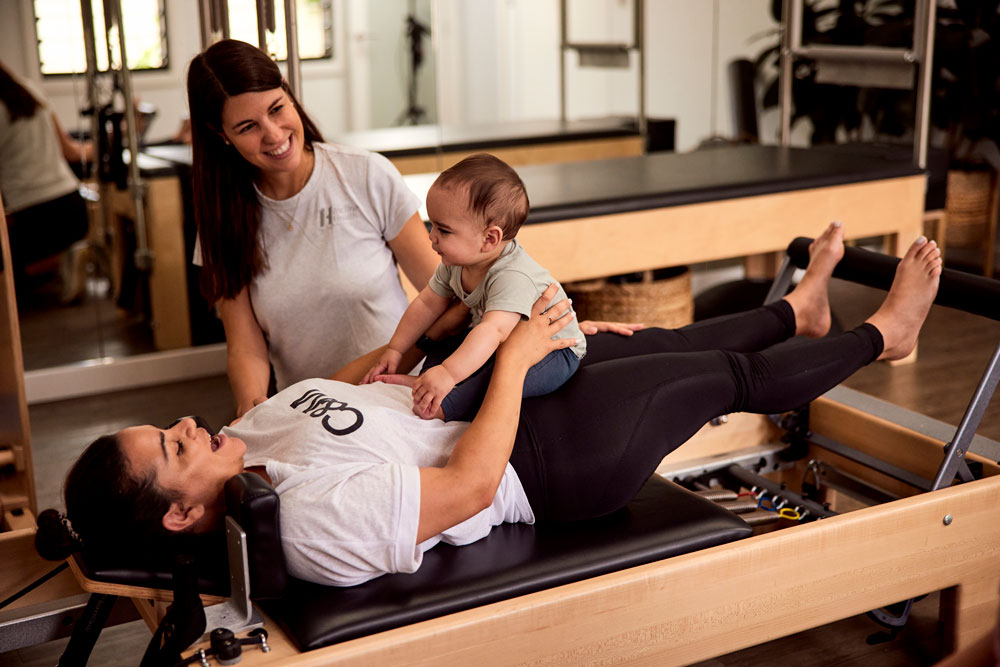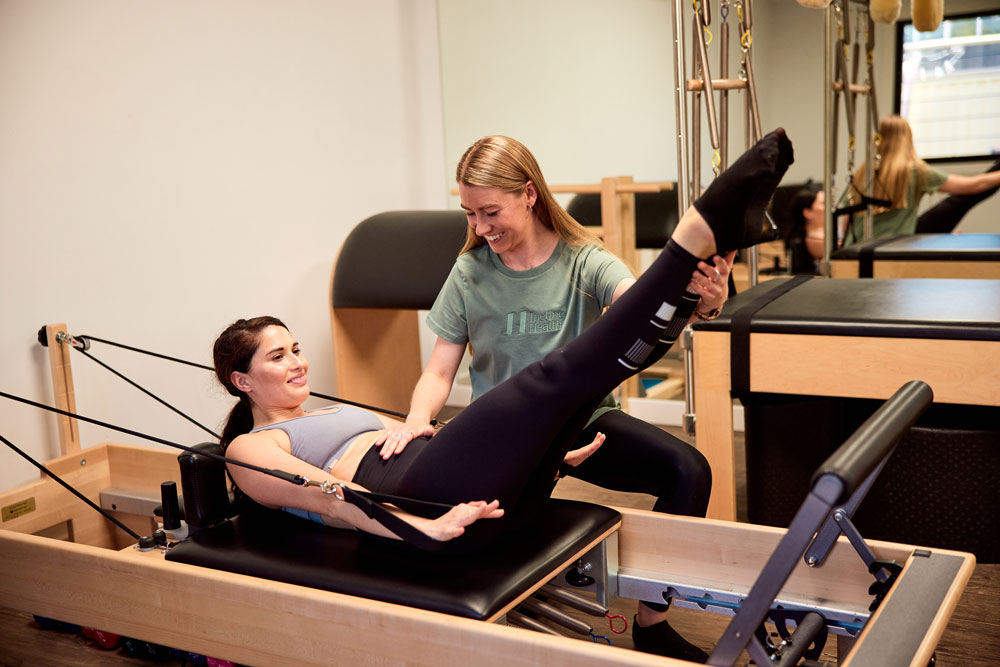Is Pilates Safe During Pregnancy?
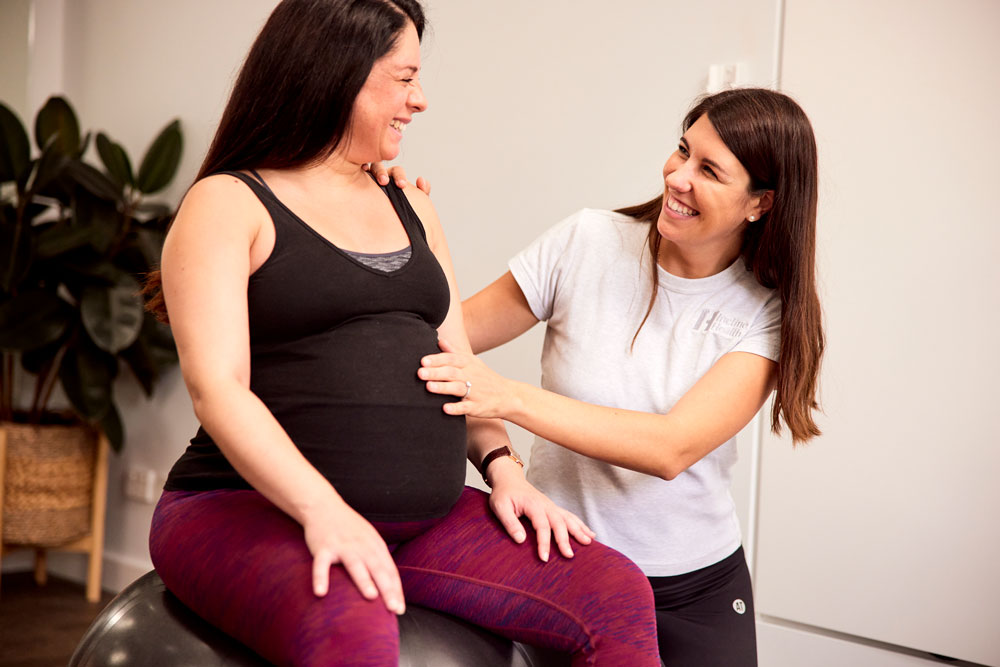

Many women often ask this important question: is Pilates safe during pregnancy? With endless information available online, it can be confusing and even overwhelming for expectant mothers to know what advice to trust. It’s completely natural to feel cautious when choosing the right form of exercise, especially when your priority is protecting both your own health and your baby’s well-being.
Pregnancy is a time of significant physical and emotional change, and the choices you make about movement and fitness can have a lasting impact. As your body adjusts to the demands of a growing baby, exercise that is safe, supportive, and effective can make a world of difference. Gentle yet strengthening practices such as prenatal pilates are designed to improve posture, build core strength, support the pelvic floor, and reduce common pregnancy discomforts, helping you maintain overall health, confidence, and energy throughout this transformative journey.
Pilates as a Low-Impact Option
Pilates is widely recommended as a safe, low impact exercise during pregnancy, making it an excellent choice for a pregnant person who wants to remain active while caring for their changing body. Unlike high-intensity workouts, Pilates places minimal stress on the joints, yet it effectively strengthens key muscle groups needed during this stage of life. The method emphasises gentle, controlled movements that allow expectant mothers to exercise without strain, while also promoting body awareness and better coordination. Equally important is its focus on mindful breathing, which not only helps improve oxygen flow and relaxation but can also support stress management and preparation for labour.
Another core principle of Pilates is alignment. As posture naturally shifts due to the growing bump and changes in the centre of gravity, many women experience back pain or pelvic discomfort. Pilates encourages safe alignment, helping to reduce pressure on the spine and pelvic floor muscles while improving stability and balance. Because it can be adapted for each trimester, Pilates provides flexibility to match a pregnant woman’s energy levels and physical needs. Together, these elements make Pilates one of the most supportive and beneficial ways to stay active and strengthen the entire body during pregnancy.
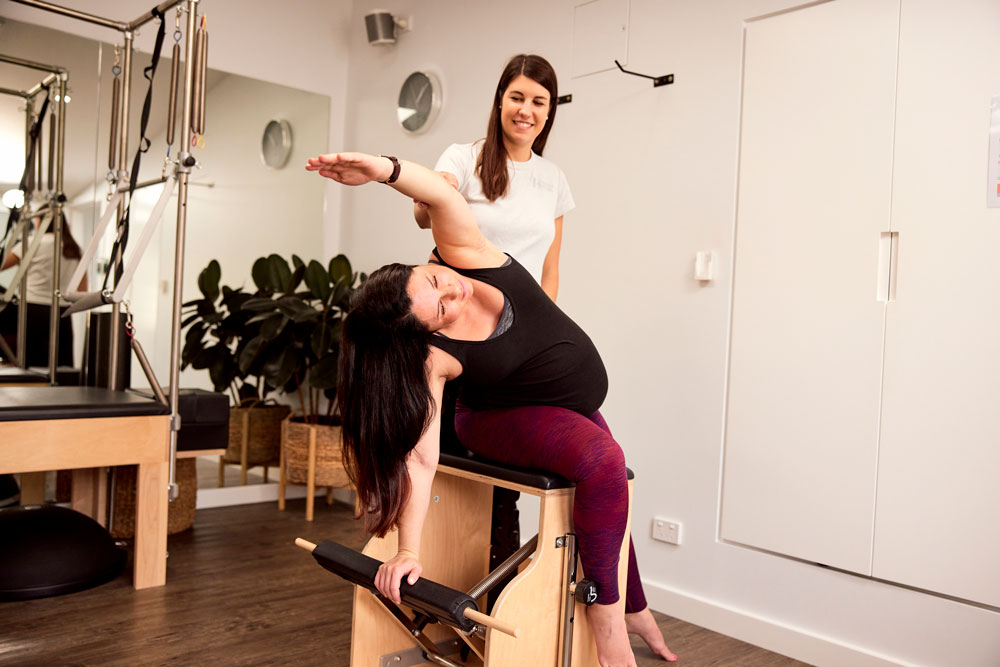

Principles of Pilates Explained
At its core, Pilates emphasises balance, posture, and breathing, three principles that become especially valuable during pregnancy. As the body changes, expectant mothers often notice gravity shifts in weight distribution, reduced stability, and added pressure on the spine and pelvis. Pilates directly addresses these issues by focusing on exercises that build awareness of posture, improve stability, and encourage efficient breathing patterns. This combination not only enhances comfort throughout daily activities but also prepares the body for the physical challenges of labour and recovery.
Originally created to strengthen the entire body, Pilates has grown to include a variety of approaches. Mat Pilates uses bodyweight and small props such as balls or resistance bands, offering gentle, floor-based movements that are easy to modify during each trimester. Reformer Pilates, on the other hand, incorporates a specialised machine with adjustable springs to provide resistance and support. With guidance from a qualified Pilates instructor, both mat and reformer sessions can be safely adapted for pregnant women, ensuring movements remain supportive rather than strenuous. Whether performed on the mat or reformer, Pilates encourages mindful, controlled practice that builds strength, protects the pelvic floor, and helps women feel confident and supported as their pregnancy progresses.
So, Is Pilates Safe When You’re Pregnant?
General Guidelines from Health Experts
Exercise during pregnancy can help regulate weight gain, improve cardiovascular health, reduce the risk of gestational diabetes, and promote emotional well-being. Within these recommendations, Pilates during pregnancy is recognised as a particularly effective option because it is low impact, adaptable, and focuses on areas of the body most affected by pregnancy.
The key, however, is modification. As pregnancy progresses, the body undergoes major physical changes: increased blood volume, shifting gravity, and a growing bump that alters posture and balance. Because of this, some traditional Pilates exercises are no longer appropriate, especially those that place direct strain on the abdominal muscles or require lying flat on the back for extended periods. Expert-guided adjustments ensure that prenatal Pilates exercises support strength and mobility without overloading the pelvic floor or causing discomfort.
Importance of Medical Clearance
While Pilates is considered safe, every pregnancy is unique, and what feels right for one woman may not be suitable for another. This is why medical clearance from a GP, obstetrician, or midwife is essential before beginning or continuing any structured exercise program. A healthcare professional can assess an individual’s medical history, current pregnancy health, and potential risk factors, such as high blood pressure, placenta previa, or a history of miscarriage or preterm labour.
Securing approval not only ensures safety but also builds confidence for the mother-to-be, knowing that she is exercising responsibly. It also opens the door for tailored advice—health professionals may highlight specific movements to avoid or recommend additional support, such as working closely with a physiotherapist or a certified Pilates instructor experienced in prenatal care. For women with special circumstances, alternatives like one-on-one physiotherapy sessions may be more appropriate than group classes.
Why Pilates Is Considered Safe
Pilates is often described as one of the most adaptable and safe exercise routines for pregnant women because it combines several protective elements: gentle strength-building, posture alignment, and mindful breathing techniques. Strengthening the core and surrounding stabilising muscles provides much-needed support for the spine and pelvis as the body prepares for the increasing demands of each trimester. Correcting posture reduces common complaints such as back pain and pelvic discomfort.
Breathing work is equally valuable. Pilates encourages deep, controlled breaths, which help manage stress, improve oxygen flow, and build awareness of how the body moves during exercise. These skills are not only useful during pregnancy but also during labour, when breath control and stamina are vital. Unlike high-intensity workouts, Pilates does not rely on fast or high-impact movements. Instead, it focuses on gentle movements that can be adjusted to suit the changing needs of each trimester.
Benefits of Pilates for Pregnant Women
Supporting Core Strength and Stability
Pregnancy places extra strain on the core. Pilates helps maintain safe core strength and improve muscle tone , supporting the pelvic floor muscles and spine.
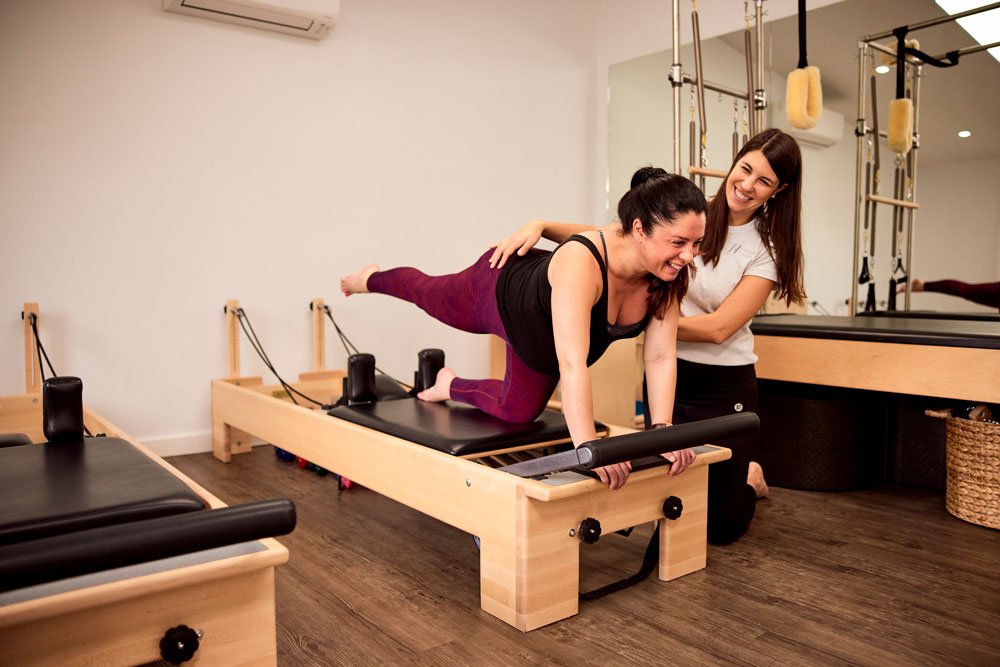

Reducing Pain and Discomfort
Pain in the lower back, pelvis, and hips is common as the body changes. Pilates strengthens supporting muscles and promotes alignment, which can reduce discomfort.
Promoting Relaxation and Stress Relief
Mindful breathing and gentle movements help lower stress and promote relaxation, improving overall well-being during pregnancy.
Preparing the Body for Labour
Pilates builds stamina and pelvic floor strength, supporting the body as it prepares for the process of giving birth.
Trimester-by-Trimester Safety Tips & Modifications
First Trimester Safety
In the first trimester, most regular Pilates exercises are safe. Focus on gentle movements that maintain core strength and posture.
Second Trimester Modifications
During the second trimester, the growing belly makes supine (lying on your back) exercises less safe. Modifications ensure good blood flow and protect against dizziness or nausea.
Third Trimester Adjustments
By the third trimester, gentle movements are key. Exercises should be supportive, low-impact, and help maintain mobility without overexertion.
Movements to Avoid
Across all trimesters, it’s best to avoid exercises such as deep twists, strong abdominal crunches, high-impact moves, and of course, always avoid hot Pilates due to risks of overheating and blood pressure changes.
Pilates vs Other Prenatal Exercises
Pilates vs Yoga in Pregnancy
Many women compare Pilates vs yoga pregnancy. While yoga emphasises flexibility and relaxation, Pilates targets core stability and pelvic floor support, making it suitable for pregnant people . Both are safe when taught by experienced instructors.
Pilates vs Walking and Swimming
Walking and swimming are excellent low impact exercises that boost circulation and maintain energy levels. Pilates, however, provides targeted strengthening of the abdominal muscles and pelvic floor, making it uniquely beneficial.
Unique Benefits of Pregnancy Pilates
Pregnancy Pilates combines gentle movements with strengthening, breathing, and posture correction, providing many benefits beyond standard workouts.
When to Avoid Pilates
High-Risk Pregnancy Situations
In some cases—such as placenta previa, preeclampsia, or a history of preterm labour—it may not be safe to continue certain prenatal pilates exercises. Always check with your healthcare provider.
Warning Signs to Stop Exercising
If you feel dizzy, experience pain, or feel fatigued unusual fatigue, or bleeding, stop immediately. Listening to your body is the best way to ensure safety.
Physiotherapy as an Alternative During Pregnancy
Benefits of Physiotherapy
Pregnancy physiotherapy supports women with specific needs such as diastasis recti, pelvic floor pain, or other conditions affecting mobility.
Why Physiotherapy May Be Needed
Sometimes, expectant mothers need more individualised care than group Pilates workouts provide. A physiotherapist can design a safe, personalised exercise program.
Expert Recommendations & Resources
Importance of Qualified Instructors
Working with a qualified Pilates instructor or physiotherapist trained in prenatal care ensures modifications are correct and effective.
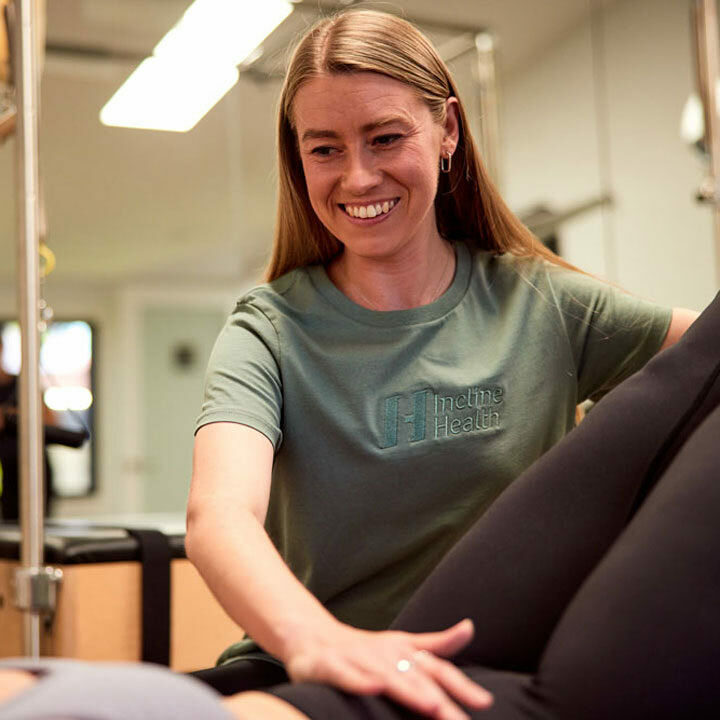

Role of Reformer Pilates
Reformer Pilates is often safe during pregnancy when guided by an expert instructor. Adjustable springs and supportive positions allow pregnant women to move safely at their own pace.
Evidence-Based Practice
Studies highlight that prenatal Pilates improves posture, reduces pain, and prepares the body for postpartum recovery. Many trials confirm benefits for moms to be, especially when guided by an experienced instructor.
So, is Pilates safe during pregnancy?
For most women, the answer is yes to pilates during pregnancy —with the right guidance, modifications, and medical approval. Prenatal Pilates offers many benefits, from improved posture and reduced pain to better pelvic floor strength and preparation for labour.
If you’re curious about starting Pilates while pregnant, speak with your doctor first, then seek out a certified Pilates instructor or physiotherapist who specialises in prenatal care.
Book a Prenatal Pilates class or physiotherapy consultation.
FAQs on Pilates During Pregnancy
What Pilates moves should be avoided during pregnancy?
Avoid lying flat on your back after the first trimester, deep abdominal crunches, heavy twisting, and any high-impact or overheated activities like hot Pilates.
How far into pregnancy can you do Pilates?
With modifications, Pilates sessions can usually continue into the third trimester. Always work at your own pace and under supervision.
Is Pilates OK in early pregnancy?
Yes, in the first trimester, most Pilates exercises are safe. Focus on gentle movements and consult your healthcare provider.



